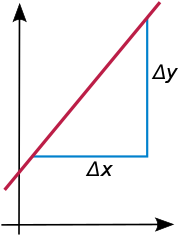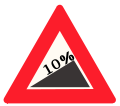Slope
From Wikipedia, the free encyclopedia
| Look up slope in Wiktionary, the free dictionary. |
Slope is used to describe the steepness, incline, gradient, or grade of a straight line. A higher slope value indicates a steeper incline. The slope is defined as the ratio of the "rise" divided by the "run" between two points on a line, or in other words, the ratio of the altitude change to the horizontal distance between any two points on the line. It is also always the same thing as how many rises in one run.
Using calculus, one can calculate the slope of the tangent to a curve at a point.
The concept of slope, and much of this article, applies directly to grades or gradients in geography and civil engineering.
Contents |
Definition
The slope of a line in the plane containing the x and y axes is generally represented by the letter m, and is defined as the change in the y coordinate divided by the corresponding change in the x coordinate, between two distinct points on the line. This is described by the following equation:
(The delta symbol, "Δ", is commonly used in mathematics to mean "difference" or "change".)
Given two points (x1, y1) and (x2, y2), the change in x from one to the other is x2 - x1, while the change in y is y2 - y1. Substituting both quantities into the above equation obtains the following:
Note that the way the points are chosen on the line and their order does not matter; the slope will be the same in each case. Other curves have "accelerating" slopes and one can use calculus to determine such slopes.
Examples
Suppose a line runs through two points: P(1, 2) and Q(13, 8). By dividing the difference in y-coordinates by the difference in x-coordinates, one can obtain the slope of the line:
The slope is  .
.
As another example, consider a line which runs through the points (4, 15) and (3, 21). Then, the slope of the line is
Geometry
The larger the absolute value of a slope, the steeper the line. A horizontal line has slope 0, a 45° rising line has a slope of +1, and a 45° falling line has a slope of -1. A vertical line's slope is undefined meaning it has "no slope."
The angle θ a line makes with the positive x axis is closely related to the slope m via the tangent function:
and
(see trigonometry).
Two lines are parallel if and only if their slopes are equal and they are not coincident or if they both are vertical and therefore have undefined slopes. Two lines are perpendicular if the product of their slopes is -1 or one has a slope of 0 (a horizontal line) and the other has an undefined slope (a vertical line). Also, another way to determine a perpendicular line is to find the slope of one line and then to get its reciprocal and then reversing its positive or negative sign (e.g. a line perpendicular to a line of slope -2 is +1/2).
Slope of a road
- Main articles: Grade (slope), Grade separation
There are two common ways to describe how steep a road or railroad is. One is by the angle in degrees, and the other is by the slope in a percentage. See also mountain railway. The formulae for converting a slope as a percentage into an angle in degrees and vice versa are:
and
where angle is in degrees and the trigonometry functions operate in degrees. For example, a 100% slope is 45°.
A third way is to give one unit of rise in say 10, 20, 50 or 100 horizontal units, e.g. 1:10. 1:20, 1:50 or 1:100 (etc.).
|
Slope warning sign in the Netherlands |
Slope warning sign in Poland |
A 1371-meter distance of a railroad with a 20‰ slope. Czech Republic |
Steam-age railway gradient post indicating a slope in both directions at Meols railway station, United Kingdom |
Algebra
If y is a linear function of x, then the coefficient of x is the slope of the line created by plotting the function. Therefore, if the equation of the line is given in the form
then m is the slope. This form of a line's equation is called the slope-intercept form, because b can be interpreted as the y-intercept of the line, the y-coordinate where the line intersects the y-axis.
If the slope m of a line and a point (x0, y0) on the line are both known, then the equation of the line can be found using the point-slope formula:
For example, consider a line running through the points (2, 8) and (3, 20). This line has a slope, m, of
One can then write the line's equation, in point-slope form:
or:
The slope of a linear equation in the general form:
is given by the formula:
Calculus
The concept of a slope is central to differential calculus. For non-linear functions, the rate of change varies along the curve. The derivative of the function at a point is the slope of the line tangent to the curve at the point, and is thus equal to the rate of change of the function at that point.
If we let Δx and Δy be the distances (along the x and y axes, respectively) between two points on a curve, then the slope given by the above definition,
 ,
,
is the slope of a secant line to the curve. For a line, the secant between any two points is the line itself, but this is not the case for any other type of curve.
For example, the slope of the secant intersecting y = x² at (0,0) and (3,9) is m = (9 - 0) / (3 - 0) = 3 (which happens to be the slope of the tangent at, and only at, x = 1.5, a consequence of the mean value theorem).
By moving the two points closer together so that Δy and Δx decrease, the secant line more closely approximates a tangent line to the curve, and as such the slope of the secant approaches that of the tangent. Using differential calculus, we can determine the limit, or the value that Δy/Δx approaches as Δy and Δx get closer to zero; it follows that this limit is the exact slope of the tangent. If y is dependent on x, then it is sufficient to take the limit where only Δx approaches zero. Therefore, the slope of the tangent is the limit of Δy/Δx as Δx approaches zero. We call this limit the derivative.
See also
- The gradient is a generalization of the concept of slope for functions of more than one variable.
- Slope definitions
External links
- Interactive applet demonstrates how to calculate slope of a line






















